Dell UltraSharp U2711: Quality has a Price
by Jarred Walton on January 22, 2010 2:00 AM EST- Posted in
- Displays
Dell U2711 Color Quality
We'll start with a look at the color quality of the U2711, broken down into two areas: Color gamut and color accuracy (i.e. Delta E). We'll start by explaining the former. Color gamut refers to the ability for a display to represent all of the colors in a defined selection of colors. In this case, we use the Adobe RGB standard to define the base gamut, and we measure the percentage of that standard that a display is able to cover - higher being better.
Delta E is the difference between a requested color and the color that actually appears on the display, with lower being better - i.e. the displayed color doesn't have a large delta relative to what was requested. If a display has perfect color accuracy, Delta E will be 0.0; in practice, anything less than 1.0 is nearly perfect and no one will notice the difference. A Delta E of 2.0 or less is the desired result after calibration, meaning no one color measures higher than 2.0 on our standard 24 color palette. Such a result would be fit for use in any professional imaging environment. Finally, while Delta E of around 4.0 is visible to the naked eye, it's really a question of reference points; if you don't have something better nearby and you're not going to print or view content on other media, a result where all colors measure 4.0 or less is very good.
So how does the U2711 do in these areas? First let's look at the charts, and then we'll discuss what they mean. We used the Graphics and Adobe RGB setting on the U2711, with brightness set at 36% (~200nits) and contrast at the default 50%.
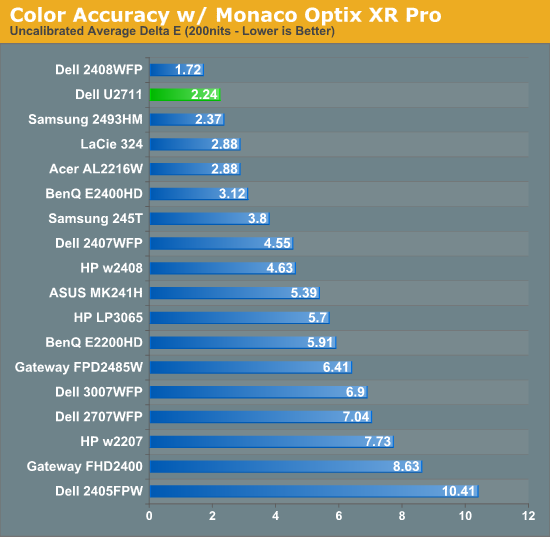
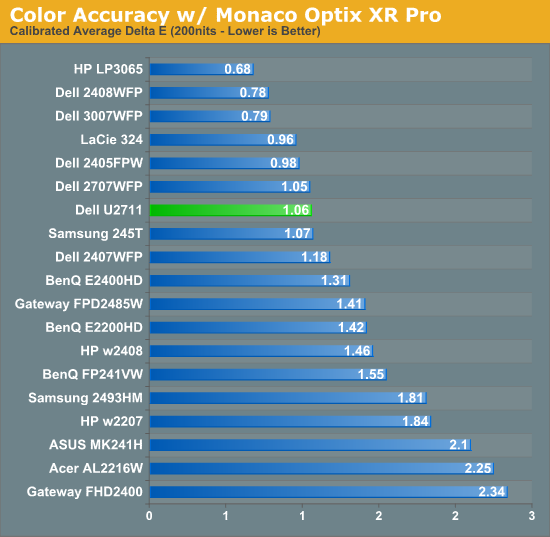
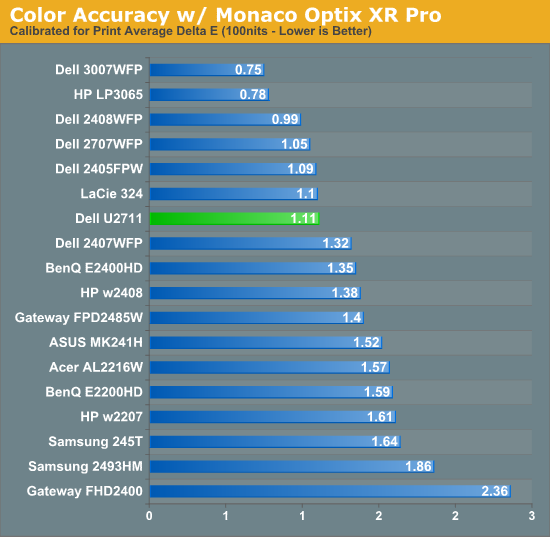
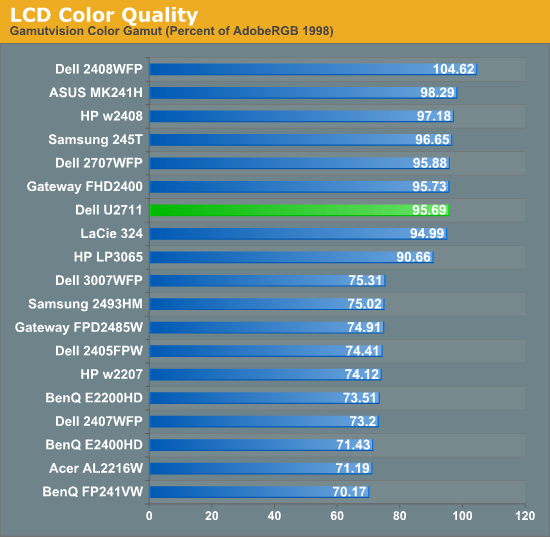
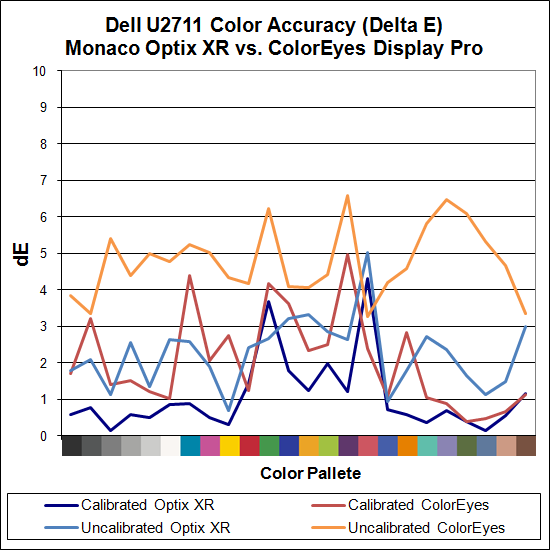
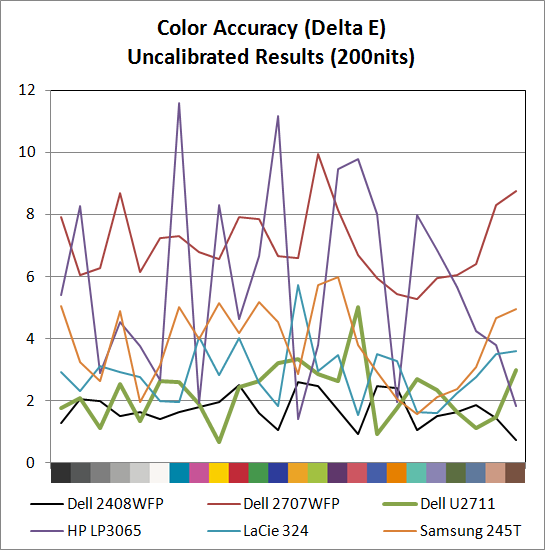
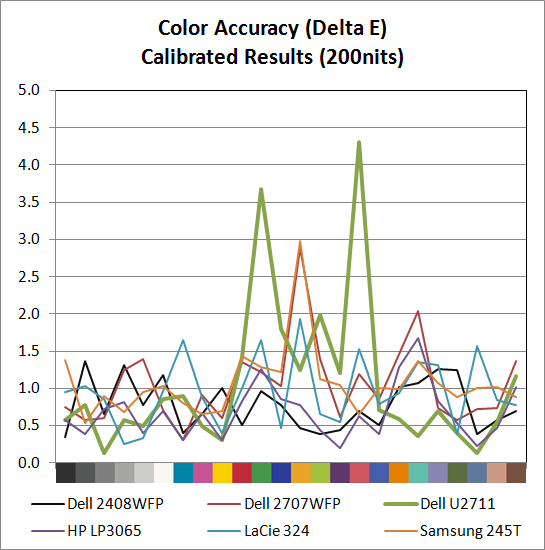
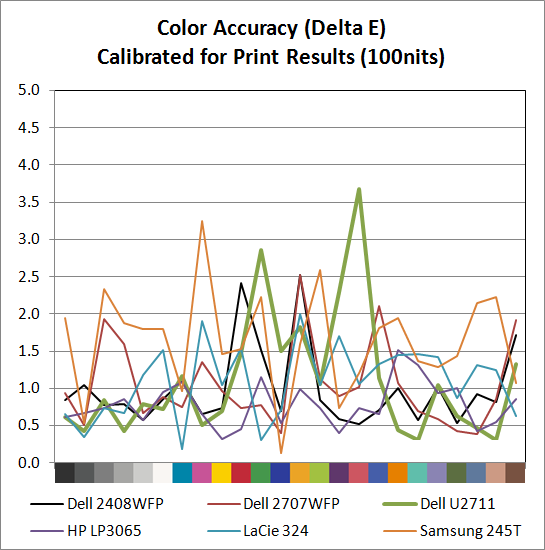
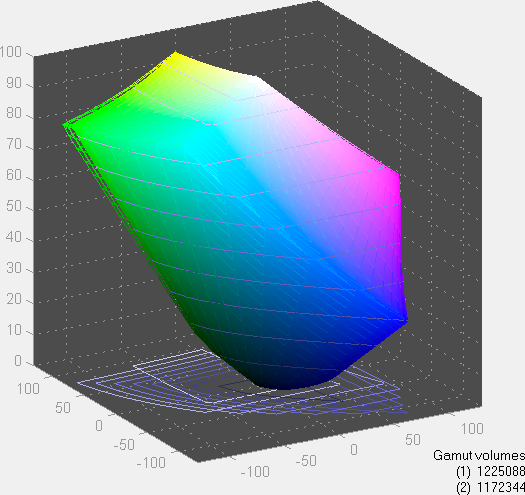
The U2711 scores extremely well in color gamut, and it achieves the 96% of Adobe RGB that Dell claims in their literature (not that most users would really notice the difference between any of the displays rated 90% to 105% - at least not after you eliminate the TN panels). Color accuracy on the other hand is a bit of a mixed bag. Dell ships a paper with test results showing the color calibration of each individual U2711, with the claim that the displays will have an average Delta E of less than 5.0 without any end-user calibration (when using the sRGB and Adobe RGB settings). Dell uses Minolta Color Analyzer CA210 and 32 test colors while we test with ColorEyes Display Pro and Monaco Optix XR Pro and 24 test colors, but our Monaco results confirm their claim. We're not sure why, but we continue to get better results using Optix XR Pro than with ColorEyes Display Pro.
As far as Optix is concerned, the U2711 achieves the rated Delta E of < 5.0 at just 2.24 without calibration, which is an excellent result. In fact the U2711 has no colors in the standard Gretag Macbeth 24 color palette score higher than 5.0 (and only reddish-pink scores a 5.0 measurement). The only LCD we've tested that did better is Dell's own 2408WFP (which also, interestingly enough, had an Adobe RGB color gamut of 105%). ColorEyes also gives an average Delta E of less than 5.0, but at 4.78 the score isn't nearly as remarkable, with nine color measurements well above 5.0. The uncalibrated (Monaco) results put the U2711 ahead of the HP LP3065, Dell 2707WFP, Samsung 245T, and LaCie 324 - and just about every other LCD we've tested.
Switch to the calibrated results and the U2711 doesn't impress quite as much relative to the competition. Monaco gives the U2711 an average Delta E of 1.06, which is great, but there are two results above 3.0 (the worst is reddish-pink again, this time at 4.31) compared to displays like the HP LP3065 where the highest measured Delta E is just 1.68. Dell's own 2707WFP, a three-year-old offering, also delivered a similar average Delta E but with only two colors above 2.0 (and still under 3.0). For a better LCD (i.e. not a TN panel), the results are really only slightly above average. It is possible different calibration software would achieve a better end result, but really we're talking about a "problem" that only the most demanding users are likely to ever notice.
Color Consistency
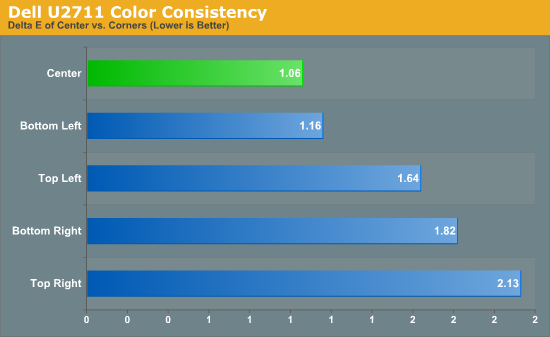
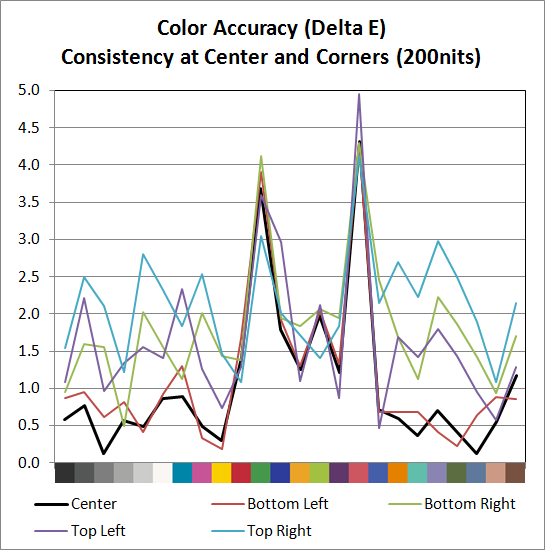
We added another test to try and measure the panel consistency across the entire surface. We measure Delta E at the center of the display, but what happens on the edges? To test this, we used the same profile generated in our best Delta E test result and measured Delta E again at the four corners. Most of the scores are similar, with a slight increase in average Delta E relative to the center measurement. The bottom-left corner is nearly identical to the center measurement, the top-left and bottom-right are a bit worse, and the top-right corner gets the overall worst result. While on the one hand we could say that the Delta E on the top-right is twice that of the center measurement, it's not a case of being "twice as bad". In fact, the color consistency is very good, and we didn't notice any "hot spots" are areas where the colors were clearly off relative to the rest of the LCD.










153 Comments
View All Comments
poohbear - Friday, January 22, 2010 - link
a 27" lcd monitor review??? you guys should do your research and see what your users actually use, what portion of your demographics actually use a 27" $1000+ monitor? write articles that are practical for your users and that your users would be interested in, no this i have $1000 lying around and then ontop of that i have $700 for an sli or crossfire setup to handle the insanely high resolution for this monitor.i expected more from u guys.
Voo - Saturday, January 23, 2010 - link
Wouldn't that mean that AT also should stop reviewing new CPUs, because the majority of users only buy some cheap Phenoms or core2s?Would be rather boring.. not that you can't (and shouldn't) also review cheaper monitors, but I don't think it has to be a "either or".
Raoul Duke - Saturday, January 23, 2010 - link
As someone looking to replace a 30" LCD I completely disagree. This article had perfect timing for me as I was planning on purchasing the Dell 2709W next week. This was an article I found well written and informative.CSMR - Saturday, January 23, 2010 - link
Modern integrated graphics can handle this monitor. You just need a dual dvi output or displayport (or sufficiently good hdmi I guess).AnnonymousCoward - Saturday, January 23, 2010 - link
I spent $1500 on my 30". Worth every penny. And my car costs less than yours.kmmatney - Saturday, January 23, 2010 - link
I sort of agree. While its great to see reviews of high end monitors, there are also a lot more interesting monitors to review, such as the new e-IPS displays. I bought the new NEC 23" e-IPS display, and I also own a Soyo 24" MVA display. These were both around $300 (and the Soyo is better , btw, but you can't buy it anymore). Would be nice to see a review of the NEC or Viewsonic 23" eIPS displays.Pandamonium - Friday, January 22, 2010 - link
Maybe this is idiotic, but what if you mounted a midrange computer to the back of the panel? It shouldn't be too difficult to modify a shim to go between the panel and the stand that can hold a smallish desktop. Maybe I've been struck with the Apple bug, but there's something to be said for minimizing wire clutter. If Apple weren't hell-bent on proprietary video inputs, I'd be looking at the 27" iMac more carefully. So instead I'm trying to figure out how you could do something similar in the PC world.CSMR - Friday, January 22, 2010 - link
I wouldn't use apple if you gave me for free, but they do have better video connections than PC, PC makers have all these legacy connections including VGA while apple was quick to DVI and then displayport. They chose a strange displayport plug but that's all you can blame them for.But various PC makers have all-in-ones. I think Sony makes at least one with a good screen.
CSMR - Friday, January 22, 2010 - link
Good information about a good product I'll definitely consider. But I was disappointed by novice errors about pixel pitch.Claim: Small pixel pitch makes text hard to read. The windows dpi setting is limited to 96 and 120.
This is a particularly bad error because so many people fall for it. It's important for a tech site to hammer home the right answer here so that people set up their displays right. Smaller dpi always improves text. It doesn't make text smaller because you just adjust the dpi setting to whatever you want. Smaller dpi just gives better-resolved text. XP had problems but since Vista this has worked well in Windows so you shouldn't perpetuate this mistake.
(Now with icons and web images, yes you may get minor artifacts of scaling, but this is becoming less and less of an issue, and the lower the pixel pitch the less of an issue it is.)
JarredWalton - Friday, January 22, 2010 - link
The text isn't worse; it's simply smaller, and *that* is indeed harder to read for many people (especially those who are 40 and older).Changing the DPI will help with the text problem, true, but there are all sorts of other artifacts. Take web sites that tend to use a set width (AnandTech and tons of others). You can get big text with a change in DPI, but the images stay the same. It's not an ideal way of working.
Also, if you're working at a 120 DPI, documents and spreadsheets and such don't look the same on other PCs running the default 96 DPI. It's one of those "issues" I glossed over. Icons are another. When I switched, there were all sorts of oddities that I wasn't anticipating; I've mostly come to grips with them, but it would have been nice if the 120 DPI setting had just scaled everything but images "perfectly".
I suppose that ideally I'd want my text DPI set at 192 for some things, but I'd prefer my icons and Windows UI elements to stay at 96, and other areas would be nice to have at 120, and.... You get the point. I think by using the magnification capabilities of Word, Excel, and most browsers I can get around changing the DPI altogether... almost.
Basically, higher DPI (finer dot pitch) is good for some people and in some usage scenarios, and potentially bad in others, depending almost entirely on user preference. In the case of the U2711, I'd almost rather run it at 1920x1080 with sharpness at 60-70% than deal with the DPI stuff... expect I really like 2560 width when you work with large images.